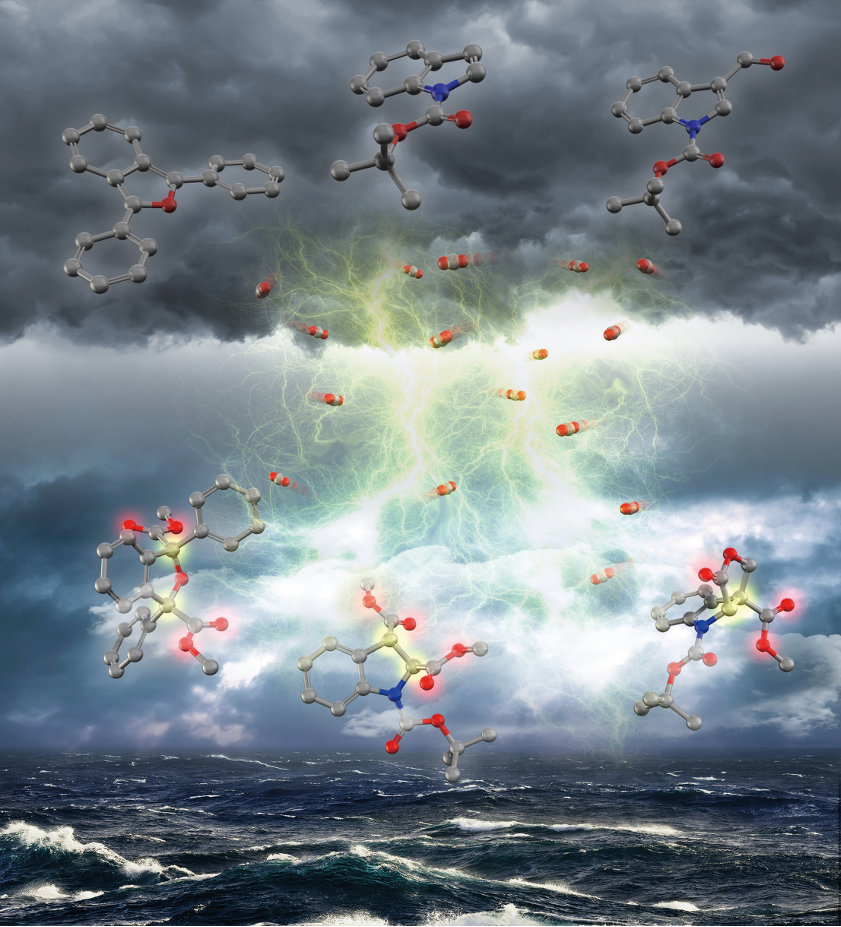Researchers at the Institute for Chemical Reaction Design and Discovery (ICReDD) at Hokkaido University have formulated a technique that has the potential to assist in the recycling of waste carbon dioxide (CO2) while also creating molecules beneficial for drug development.
 Artistic depiction of electricity enabling the addition of CO2 to heteroaromatic compounds. Image Credit: Tsuyoshi Mita.
Artistic depiction of electricity enabling the addition of CO2 to heteroaromatic compounds. Image Credit: Tsuyoshi Mita.
Besides the eternally crucial demand for carbon-neutrality, chemists are progressively keen on using CO2 in syntheses since it is plentiful, economical, renewable and relatively nontoxic. But its reactivity is comparatively low.
To surpass this, the team guided by Professor Tsuyoshi Mita applied an electrochemical technique wherein an electron is incorporated into either the CO2 molecule or to the other molecule in the solution, rendering it much easier for them to react with each other.
This study marks a particularly huge breakthrough since CO2 is used to conduct a traditionally challenging type of transformation with unparalleled efficiency. When specific conditions are met, electrons can be shared between a number of atoms in a molecule by what is known as an aromatic system.
These systems are particularly stable and hard to break, but the new technique formulated at ICReDD can dearomatize, or break, these stable aromatic systems by incorporating CO2 into the molecule using electricity.
This method has the potential to recycle CO2 as well as produce high value-added dicarboxylic acids from basic starting materials, solving two issues simultaneously.
Before the actual experiments, researchers from ICReDD screened numerous heteroaromatic compounds by assessing their reduction potentials, which is a measure of how a compound will react when exposed to an electric environment.
The results allowed the scientists to detect potentially reactive compounds and perform targeted electrochemical experiments. They show that a wide range of substrates that display highly negative reduction potentials can very efficiently experience this extraordinary dearomative incorporation of two CO2 molecules.
The acquired dicarboxylic acids can be cost-effectively altered without difficulty into important intermediates for biologically active compounds, which could pave the way for more efficient and cost-effective drug development.
Scientists involved in the study credit the fast development of this new method to their strategy of first conducting computational analyses that aided their experimental selections in the lab.
I started to learn computational chemistry when I joined ICReDD. Within one year, I was able to utilize advanced calculation techniques, which was very useful for guiding my decisions in the lab.
Dr. Yong You, Study First Author, Institute for Chemical Reaction Design and Discovery, Hokkaido University
“It took only eight months to complete the research and publish the paper, which is much faster than a conventional project involving experiments. Significant research time is saved because a computer can reliably predict the feasibility of the reactant structures and possible reaction pathways” observed Tsuyoshi Mita, who led this study.
Funding
This research received financial support from the Japan Science and Technology Agency’s Exploratory Research for Advanced Technology (JST-ERATO; JPMJER1903); the Japan Society for the Promotion of Science’s World Premier International Research Center Initiative (JSPS-WPI), and a Grant-in-Aid for Challenging Research (Exploratory) (21K1894501); the Fugaku Trust for Medical Research; the Uehara Memorial Foundation; and the Naito Foundation.
Journal Reference:
You, Y., et al. (2022) Electrochemical Dearomative Dicarboxylation of Heterocycles with Highly Negative Reduction Potentials. Journal of the American Chemical Society. doi.org/10.1021/jacs.1c13032.